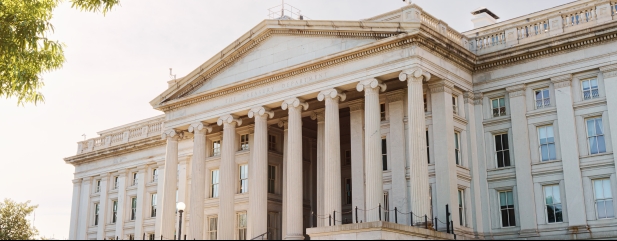Archived article
Please note that tax, investment, pension and ISA rules can change and the information and any views contained in this article may now be inaccurate.
Is the US treasury market about to go on tilt?

The White House’s trade policy hokey-cokey continues, with new duties on steel and aluminium, even as the 9 July deadline for the nation-by-nation reciprocal tariffs draws ever closer.
Stock markets are still assuming we are past the worst, given the furious rally from the lows on 8-9 April, barely a week after the Liberation Day bombshells, on the basis deals will be done, economic growth will continue, inflation will remain benign, and interest rates will dribble lower.
However, as discussed two weeks ago, the government bond market remains unconvinced, and the longer the maturity of the paper the more obvious those doubts become.
A nice, simple proxy for the performance of long-dated US government bonds, or treasuries, is the iShares 20+ Year Treasury Bond Exchange-Traded Fund (TLT:NYSE).
This passive instrument is designed to mirror and deliver the performance of a basket of treasuries which have a lifespan of more than twenty years, minus its own running costs.
It also pays out the coupons received on a monthly basis. At the time of writing, the ETF owns 42 different US government bonds, comes with an average coupon of 2.88% and offers an average yield to maturity of 5.06%.
The yield is so much higher than the coupon on the underlying bonds because their prices, and therefore the price of the ETF, have collapsed since 2020, when inflation started to emerge and force the US Federal Reserve into interest rate hikes and quantitative tightening. Indeed, the ETF has halved from its peak, a loss which wipes out any coupons accrued and then so much more.
The key now may be where the ETF, and thus long-dated US treasury yields and prices, go next. The passive tracker has never closed below $80. At the time of writing, it trades at $84, so if that historic floor gives way, then bond vigilantes may be well and truly in charge and the rout may be on.
THE DEVIL AND THE DEEP BLUE SEA
The US long bond market seems torn between two different worries. On the one hand, it fears president Trump’s Big Beautiful Bill and the way in which the US federal deficit continues to gallop higher. This will mean more Treasury issuance and, in crude terms, may oblige the US Government to offer higher yields to lure in buyers even as supply rises.
On the other, it fears a sustained upturn in inflation, thanks to tariffs and onshoring, which come at a time when unemployment in the US is low and workers may have more of a say in negotiations over pay and conditions than they’ve had since president Ronald Reagan took on the air traffic controllers, and US unions more generally, in the early 1980s.
Both concerns seem legitimate, and they are probably inter-linked. Trump’s apparent determination to drive down the oil price is potentially helpful, and right now Saudi Arabia seems to be playing ball as OPEC increases output at a time of economic uncertainty. But his indifference to a weaker dollar and calls for lower interest rates suggest oil may be part of a bigger plan (assuming there is indeed a coherent plan).
Put together a lower oil price (which is good for consumers’ spending power and corporate margins across many industries), a weaker dollar which helps exports, lower interest rates (if Trump can prise them out of Jay Powell and the US Federal Reserve), and extended and new tax cuts with a desire to go on a deregulation drive to match that of Reagan over 40 years ago, and this could just be a recipe for rapid economic growth – especially in nominal terms, which encompasses inflation.
HOT STUFF
Rapid nominal growth is one of the five ways out of a crushing debt, and debt-to-GDP burden, as discussed in many papers and books by Carmen Reinhart and Kenneth Rogoff.
It is also the most appealing, relative to the others, which are austerity, default, inflation and a war. Yet is the hardest to achieve, though a dash of inflation can mean nominal GDP grows faster than government borrowing, and, in that case, the debt-to-GDP ratio starts to fall.
Inflation also means a government effectively pays back its lenders and bondholders with a devalued currency.
The American macroeconomics writer Luke Gromen takes this to an extreme in one of his recent articles and social media posts.
Gromen posits that America’s debt-to-GDP ratio fell from 2020 to 2022, thanks to inflation and how government revenues were boosted by capital gains taxes on a surging stock market.
He therefore pushes the numbers to suggest that double-digit inflation, another boost to capital gains tax takings from a roaring S&P 500 index and some quantitative easing to hold down treasury yields would slash the debt-to-GDP ratio in half in a handful of years.
Maybe this is what long-dated treasury owners really fear, a new version of the Roaring 20s, a hundred years after the last version.
Even capital gains from a new round of QE would surely struggle to compensate for the real-terms losses imposed by lower yields and higher inflation. Such a scenario might also explain why gold and silver continue to shine.
Important information:
These articles are provided by Shares magazine which is published by AJ Bell Media, a part of AJ Bell. Shares is not written by AJ Bell.
Shares is provided for your general information and use and is not a personal recommendation to invest. It is not intended to be relied upon by you in making or not making any investment decisions. The investments referred to in these articles will not be suitable for all investors. If in doubt please seek appropriate independent financial advice.
Investors acting on the information in these articles do so at their own risk and AJ Bell Media and its staff do not accept liability for losses suffered by investors as a result of their investment decisions.
Issue contents
Editor's View
Feature
Great Ideas
News
- Vanquis Banking has been the standout performer in a strong financial sector
- Can Carnival make waves with investors again?
- Gem Diamonds has been in a downward trend for a decade
- Where does CarMax stand on growth plans?
- Where does WPP go next as CEO heads for the exit?
- The UK market still shrinking as more mid-cap companies are taken over
- Resilient US jobs report sends stocks higher but concern lingers
 magazine
magazine








